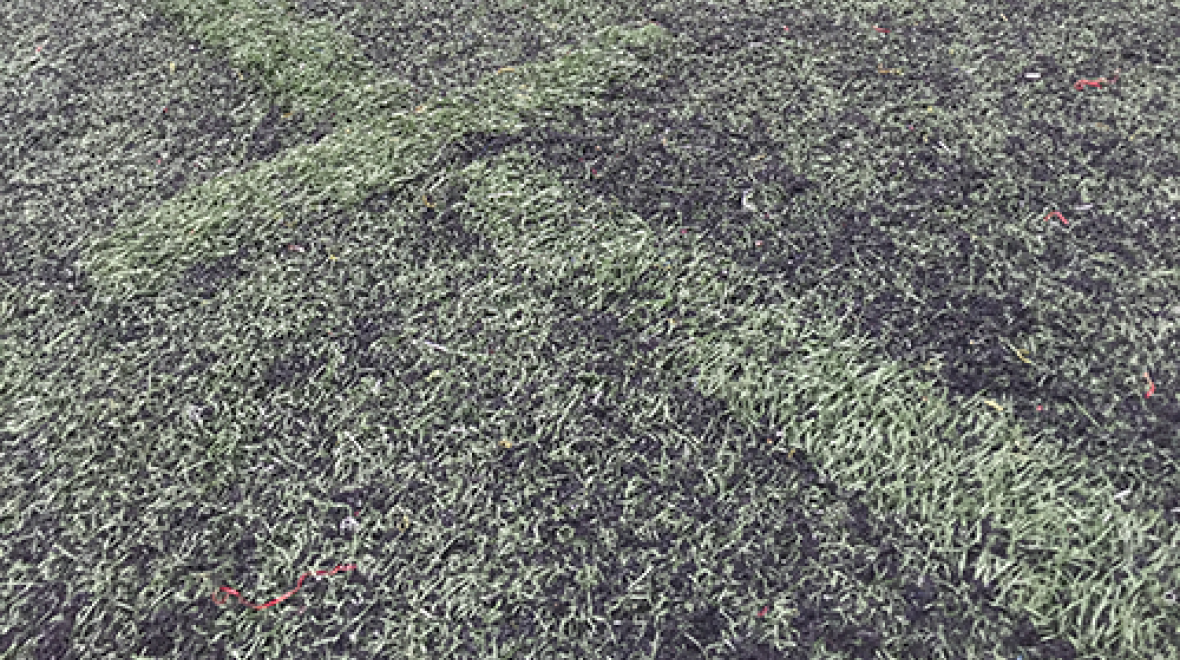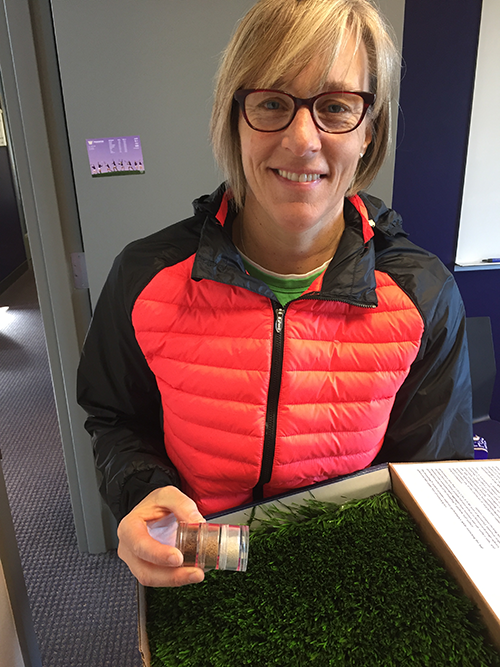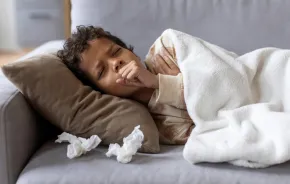
Photo:
Used tires are the most widely used infill for synthetic turfs, according to the Synthetic Turf Council (STC)
How often have I swept or vacuumed up black crumbs that have fallen off of my kids' sports uniforms and cleats over the years? Likely hundreds of times. But beside finding the crumbs annoying, I never gave them much thought. The turf fields the crumbs came from were, I knew, what my kids’ teams wanted to play on in bad weather; with the fake blades of grass, they weren't muddy and games wouldn't get cancelled because of cleats damaging soggy grass.
But as parents around the country have learned in recent years, those crumbs are, in fact, used tires, and used tires contain complicated mixtures of chemicals including benzene, mercury and arsenic, which can be dangerous on their own or when combined with other elements. Used tires are also the most widely used infill for synthetic turfs, according to the Synthetic Turf Council (STC). There are more than 8,000 multi-use synthetic turf sports fields in our nation's schools, parks and professional sports stadiums, according to the STC.
So, are our kids at risk?
An abnormal trend
Ask this question of Amy Griffin and here’s what she’ll say: ”Morally and ethically, we shouldn't be letting our kids play on trash. You can't just go down and get a tire out of a landfill, so why are we letting our kids roll around in this stuff?”

Griffin is an associate head coach for the University of Washington women's soccer team and in recent years, she has become a beacon for those concerned about turf crumbs. In 2009, she began compiling a list of all the soccer players she knew who been diagnosed with blood cancers. That list quickly grew from four players; it’s now at 237 players nationwide and includes both male and female athletes and 186 soccer players, 118 of whom are goalkeepers.
On that list is Austen Everett. In 2009, the Seattle resident was one of the country’s top goalies.
"She was in fifth or sixth grade when they were laying those turf fields,” says Everett’s mother, June Leahy. Getting scraped up was part of the goalkeeper's game. Why would Leahy have worried?
"She and the others were in one the healthiest demographics,” she says of Everett. "They were playing two to three hours a day, six days a week; they took really good care of themselves and yet they were getting cancer at an abnormal rate."
Everett died in 2012 of non-Hodgkin's lymphoma; she was 25. Leahy believes the many years that her daughter played goalie and her cancer are far from coincidental. When asked if she would still have allowed Everett to play soccer knowing what would happen later, she replies, "I would let her play soccer; I wouldn't let her play goalie. I would have had her play another position."
Four years after Everett’s death, Griffin handed a list of 53 cancer-stricken players to officials at the Washington State Department of Health (DOH). She hoped the state would investigate what Griffin was seeing on her list and conduct a study of the toxins in tire crumbs and examine routes of exposures.
In response, the DOH and researchers at the UW School of Public Health formed a team to investigate Griffin’s list. The team interviewed the players and their families and conducted a review of existing studies on turf crumbs. In January 2017, they announced their findings.
“People who enjoy soccer should continue to play irrespective of the type of field surface,” reads the report. The team said it couldn’t definitively say if turf does or does not cause cancer; in fact, “the investigation found less cancer among the soccer players than expected based on rates of cancer among Washington residents of the same ages.” The conclusion stunned Griffin.
"I felt gutted,” Griffin says. "I felt responsible that it was such an inconclusive study."
The DOH never set out to do a study, says DOH spokesman David Johnson; rather the report is an “investigation.” What's the difference? The DOH reviewed existing literature and interviewed the players on Griffin's list. There was no independent testing of the particles themselves or of the off-gassing of compounds in the crumbs on the field, which often occurs in hot weather. There was no cross-referencing of the state’s soccer players with a cancer database.
"We are not a research organization,” says Lauren Jenks, the director for the Office of Environmental Public Health Sciences at the DOH. "Where we've come to is that we know there are toxic chemicals in ground-up tires. The question is: ‘If my child is playing, are they exposed to those toxic chemicals and if so, is there an impact on their health?’ Not really."
What the science says
Meanwhile, some scientists are in the midst of their own research on turf crumbs. Dr. Stuart Shalat is an environmental epidemiologist and director of the Division of Environmental Health at Georgia State University.
The Washington DOH report, Shalat says, “does not mean there is no risk, only that this study did not find one.” The DOH suggested that there is still room for broader investigation on this question, he adds.
In his work, Shalat uses a robot called PIPER (Pretoddler Inhalable Particulate Inhalable Robotic). Using PIPER, a robot that tests air above playing fields, Shalat and his team found that the rubber tire particles in synthetic turf break down over time, making it easier to inhale them. “There are multiple routes of exposure to children from any of these compounds,” he says.
Having spent decades studying cancer and its possible environmental causes, Shalat says finding a single, definitive culprit in a cancer cluster is difficult because people are exposed to various chemicals in their daily lives. Still, he says, the research of synthetic fields done to date "massively underestimates" the potential doses of harmful chemicals children could be receiving.
"If a comprehensive study isn't mounted within the next five years, I think it's going to be almost impossible to find a group of unexposed kids in the United States,” he explained to an official with the Consumer Product Safety Commission in a January 2017 recorded teleconference. Other studies are underway with some backed by industry groups including the STC and Safe Fields Alliance.
In Portland, Dr. Archie Bleyer studies pediatric cancer at Oregon Health Sciences University. He’s less sure of a tie between turf crumbs and cancer.
"It's definitely possible there could be some level of carcinogenicity in the tissues of children, but that does not translate into actually causing cancer,” he says.
Last summer, Bleyer shared his thoughts in a June 2016 position paper on the Central Oregon Med Society website. He wrote, “We naturally have a need to find something to blame but it's not the crumb rubber or anything else in synthetic turf that caused the cancers.”
Instead, Bleyer continued, “physical activity should be encouraged and promoted by year-round, weather-resistant fields to help prevent cancer and other chronic diseases.” In other words, don’t let turf crumbs keep you from exercising.
That’s fine and good, says Washington state Rep. Gerry Pollet, but it misses the point. "We all want our kids to exercise; that is not the choice,” he says. “I don't think there would be a reduction in youth soccer if we changed the surface and, on the turf, told toddlers and goalies to take more care.” (In mentioning “toddlers,” Rep. Pollet refers to young children who may play on synthetic turf. Rep. Pollet calls them an "ignored population” when it comes to turf crumb exposure.)
In 2016, Rep. Pollet sponsored House Bill 2547 to establish procedures to test “used tire materials in recreational facilities” and require that warning signs be put up advising of the possible health risks of a facility’s synthetic turf. The bill never made it out of the House Committee on Environment, but Pollet hops to sponsor another bill during the 2018 legislative session.
We all want our kids to exercise; that is not the choice.
Outside of Washington state, there are currently two large scale studies underway. In February 2016, the Environmental Protection Agency (EPA), the Centers for Disease Control and Prevention and the Consumer Product Safety Commission launched a federal research action plan. A status report released at the end of 2016 did not include research findings.
In February 2017, EPA spokeswoman Nancy Grantham said that analysis of tire crumb samples and the exposure characterization component of the study will continue this year. Following the March 2017 news of possible EPA budget cuts, Grantham was contacted for comment about if the report is now in limbo or still ongoing. She did not respond before publication.
The state of California has also recently expanded the scope of its research; among other things, the state’s research will better identify chemicals in the crumbs, estimate the potential exposures from various activities and assess the potential health risks, says Sam Delson, an official with California's Office of Environmental Health Hazard Assessment. The final report is expected in 2019.
So, now what?
As activists, scientists and politicians continue to debate the adverse effects of turf crumbs, parents are stuck deciding how to balance a potential health risk of synthetic turf with the known health risk of diminished exercise.

With all of this in mind, would Austen Everett’s mother still have let her daughter play soccer? "It has nothing to do with the sport, so I wouldn't have discouraged her to play soccer; I'd have encouraged her to play another position." There are also safe practice standards on the field; at the UW, Griffin encourages her goalies to wear long-sleeves and pants and whenever possible have them train on grass fields.
On its website, the DOH also lists several ways to minimize potential chemical exposures, including always washing your hands after playing on the field and before eating; taking off any equipment outside or in the garage; showering after play; quickly cleaning any cuts or scrapes; and spitting out any crumb rubber that finds its way into your mouth.
Some schools aren’t waiting for more research; they’re making changes now. For two years, South Kitsap High School has used an organic infill made of cork, coconut shell and rice husk for its athletic fields. Kelly Kirk, the school's athletic director, often fields phone calls from other schools that want to tour the turf. Players and coaches give it rave reviews: "They swear our incidence of concussion is lower than when we play away games.” The only downside, Kirk says, is the need to water the turf down on hot summer days to maintain its cushioning properties.
Interest in organic infill is growing; in the last year alone, organic infills also went in at both Bobby Morris Playfield in Seattle and at Anacortes and Lakewood High School stadiums. Mercer Island High School will go with organic cork when it replaces their high school field this summer. And Vashon Island High School may too, depending on passage of a roughly $10 million school facilities bond on April 25.
"We're not up for signing on for another eight years of rubber,” says Brandy Fox, a construction consultant to both Mercer Island and Vashon. Fox says both school’s districts have heard from parents who are concerned about rubber infill.
Of course, cork and similar organic infills may not be a quick fix. Jenks of the DOH cautions: ”They sound better on the face of it but there haven't been studies." But given the known chemical make-up of cork, coconut and other organics versus that of used tires, Griffin believes it's a shift worth making: "We want to be leaders in this state where we say we are going to choose safer options."











